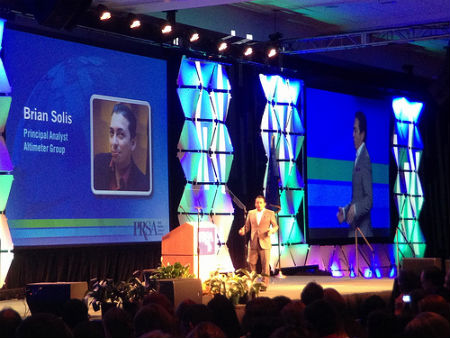 At this year’s PRSA International conference in Philadelphia, a few thousand PR professionals from all over the world gathered for the latest trends and insights into the future of PR and communications.
At this year’s PRSA International conference in Philadelphia, a few thousand PR professionals from all over the world gathered for the latest trends and insights into the future of PR and communications.
For my part, I presented on the growing role of Content Marketing for Public Relations to a packed room of attentive and inquisitive PR and communications pros.
On top of the networking, awards and education, there was plenty of connecting with old friends. I was happy to see Shonali Burke (who is handling book PR for Robert Scoble and Shel Israel’s new book, Age of Context) as soon as I walked into the venue hotel. Shortly after we connected with Richard Bagnall (founder of Metrica, acquired by Gorkana) who came over from London.
The night before his opening keynote, Brian Solis had the bright idea to take a few Uber SUVs with our pals Deirdre Breakenridge, Eric Schwartzman, Michael Pranikoff and few more friends over to Jim’s Steaks for Philly Cheesesteaks. The experience was fun, but late night cheesesteaks was just one of those things you probably only need to do once.

All that fun aside, there’s some serious business going on in the Public Relations world that has driven a lot of attention towards digital PR expertise, content marketing, native advertising and defining the future role of PR.
The PR industry has been in a state of flux over the past few years as major changes have occurred in the the news and media. One striking example is this: Over 17,000 newsroom jobs have been lost since 2007. If you’re a journalist, it doesn’t need to be Halloween for a stat like that to be scary. If you’re in media relations, it’s scary too, because with fewer journalists, competition for stories skyrockets.
On top of that, declining readership of traditional media, exploding use of social and mobile technologies, shortened news cycles and an explosion in brand publishing make today’s media environment very different. And by “different”, I mean zombie-like scary for some.
“If you want to be in the media, become the media”
Brands are evolving as publishers, hiring brand journalists and investing heavily in content. In fact, according to a recent CMI and MarketingProfs study, 58% of B2B and 60% of B2C companies planning on spending more on content in 2014. This is up a few percentage points over last year and the overall trend towards content marking is decidedly on the up.
Over 5 years ago, we decided that investing in our own content would help us create enough of an audience for our services that we wouldn’t need to rely on local or industry media. There are several ironies to how this has played out.
1. By developing our blog to be a rich information source over a long period of time, we’ve attracted far more unsolicited media coverage (NY Times, Forbes, Wall Street Journal) than when we had someone doing media outreach.
2. We still don’t get covered by the local media in Minnesota. But we also have reach that is on par or exceeds many of the business magazines. To reach 10 – 50,000 business people today, all I have to do is publish a blog post. And I can publish as many blog posts as I want without paying anyone for advertising or having to interrupt a reporter with some kind of pitch they’ll never care about anyway.
The lesson? To ensure your place as a trusted source for stories in the media, create content that demonstrates that expertise. Creating a themed, rich resource that is easily findable and shareable, will attract customers directly as well as journalists and bloggers doing research on a topic relevant to your business.
Publishers are Marketers
Publishers are increasingly offering marketing and content creation services as well as content as advertising, aka “native advertising, sponsored content or advertorial”. One of the best examples of this is Forbes Brand Voice, and recently The Associated Press started taking money for promoting content. Journalists are also becoming more accountable to driving traffic to their stories. A few years ago, the only pitches I would receive were from junior media relations specialists. Today, I’ll occasionally see pitches from newspaper, magazine or online publisher writers suggesting I share their most recent story.
We are the Internet
Along with changes with the media, brands and content are the major trends in ubiquitous internet connectivity (10 billion connected devices now) and the ability for consumers to create, consume, publish, interact and transact anytime and anywhere with smartphones, tablets or computers. The public is connected 24/7 and that creates all new means of interaction for brands that may have been used to transactions and customer service as their primary reasons for communicating with the public.
Since so many consumers are empowered to publish, companies have too look at the competition a little differently. Whether it’s the “shelf space” of search results or share of conversation on the social web, brands are not only competing against other companies, but their own customers and peers for topical attention of common interests.
Optimize for Customers, Optimize for Journalists
In the same way marketers segment customer data to create profiles that reflect key data about information discovery, consumption and what motivates action, so too can PR professionals approach content creation and optimization for journalists, analysts and reporters doing research. Time on social media and search engines means being where the target audience is looking, whether it’s buyers looking for solutions or a journalist looking for statistics or a story source. How can you be where journalists are looking? By creating and optimizing content that’s useful on “in demand” and relevant topics.
Besides findability, companies are investing in more utility for the media as well. Granted, some smart companies have been doing this a long time: creating well researched information sources on topics a particular reporter or journalist covers.
A good example is the media resource, Google Media Tools that offers members of the media a number of utilities to: Gather and Organize, Engage, Visualize, Publish, Develop and other resources. A big part of optimizing performance is to be useful and make it easier for your target audience to do what you want them to do.
What Are PR Pros Doing to Integrate Social Media and Content Marketing?
Added to the regular duties of creating messaging, communications strategy, media and blogger outreach, reputation monitoring, crisis management, employee and customer communications are some specific social media activities:
- Social Listening
- Social Content Creation
- Social Engagement
- Social Ads
- Grow Networks on Facebook, Twitter, Google+, LinkedIn, YouTube, Pinterest and forums as necessary.
As the relationship between information and influence evolves, so too must the definition of content marketing.
“Content Marketing is the planning, creation, and amplification of brand and customer focused narratives that drive measurable business outcomes.”
When you look at the idea of storytelling targeted to a specific audience intended to affect certain intended outcomes, it sounds a like influencing publics to me. When you combine that ability to incorporate key messaging into content stories with marketing level accountability – it’s a clear competitive advantage over PR or standard content marketing by itself.
Of course there’s a diverse array of skills involved with content marketing that go way beyond the purview of most PR professionals. But the messaging, ability to influence and target groups is spot on.
Both Marketing and Public Relations are in the content business. Our agency started pretty much as a PR firm and we were creating all kinds of content for clients back then. Now, we have years of experience integrating PR, marketing, advertising along with SEO, social media and content marketing. Some of the content types you’ll find PR pros creating include:
- Newsroom
- Blog Posts
- Press Releases
- Case Studies
- Social Content
- Newsletters
- Contributed Articles
- White Papers
- Events
- Video, Image, Audio
Personally, I think Public Relations pros that are skilled in messaging, content planning, social media and promotion have an excellent base to become better content marketers than many of the people now calling themselves “content marketing experts”. The main area of opportunity is in measurement, because marketers are accountable to performance and business outcomes in ways that most people in the PR world aren’t.
If you’re in the Public Relations world, how has your company started to integrate more content marketing into your services? Are clients asking for more content? Are they expecting more marketing oriented performance from your PR and media relations efforts?
Image: Shutterstock


